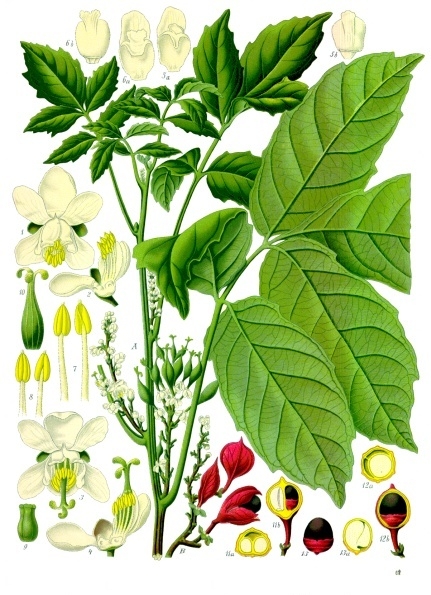 Guarana
Guarana
Common name
Guarana seed
ID
HD0163
Scientific name of the plant
Paullinia cupana Kunth ex H.B.K. var sorblis (Mart.) Ducke
Anatomical part for use
seed
Human use
Fatigue & weakness
Summary
Guaraná ( from the Portuguese guaraná [ɡwaɾɐˈna]), Paullinia cupana, syns. P. crysan, P. sorbilis) is a climbing plant in the family Sapindaceae, native to the Amazon basin and especially common in Brazil. Guaraná has large leaves and clusters of flowers and is best known for the seeds from its fruit, which are about the size of a coffee bean.
As a dietary supplement or herb, guaraná seed is an effective stimulant: it contains about twice the concentration of caffeine found in coffee beans (about 2–8% caffeine in guarana seeds, compared to about 1–3% for coffee beans). The additive has gained notoriety for being used in energy drinks. As with other plants producing caffeine, the high concentration of caffeine is a defensive toxin that repels herbivores from the berry and its seeds.The colour of the fruit ranges from brown to red and it contains black seeds that are partly covered by white arils. The colour contrast when the fruit is split open has been compared with the appearance of eyeballs and has become the basis of an origin myth among the Sateré-Mawé people.
Evidence Level
Level 0 (No convinced report of liver injury caused by herbal and dietary supplement)
Hepatotoxicity Description
N/A

Common name
Guarana seed
ID
HD0163
Scientific name of the plant
Paullinia cupana Kunth ex H.B.K. var sorblis (Mart.) Ducke
Anatomical part for use
seed
Human use
Fatigue & weakness
Summary
Guaraná ( from the Portuguese guaraná [ɡwaɾɐˈna]), Paullinia cupana, syns. P. crysan, P. sorbilis) is a climbing plant in the family Sapindaceae, native to the Amazon basin and especially common in Brazil. Guaraná has large leaves and clusters of flowers and is best known for the seeds from its fruit, which are about the size of a coffee bean. As a dietary supplement or herb, guaraná seed is an effective stimulant: it contains about twice the concentration of caffeine found in coffee beans (about 2–8% caffeine in guarana seeds, compared to about 1–3% for coffee beans). The additive has gained notoriety for being used in energy drinks. As with other plants producing caffeine, the high concentration of caffeine is a defensive toxin that repels herbivores from the berry and its seeds.The colour of the fruit ranges from brown to red and it contains black seeds that are partly covered by white arils. The colour contrast when the fruit is split open has been compared with the appearance of eyeballs and has become the basis of an origin myth among the Sateré-Mawé people.
Evidence Level
Level 0 (No convinced report of liver injury caused by herbal and dietary supplement)
Hepatotoxicity Description
N/A